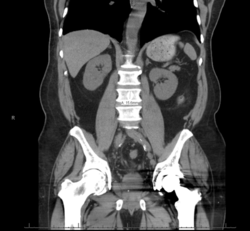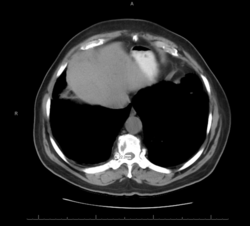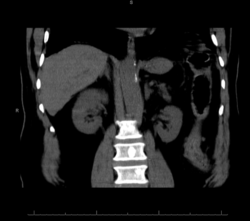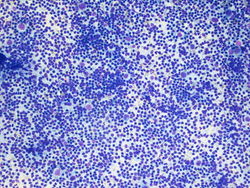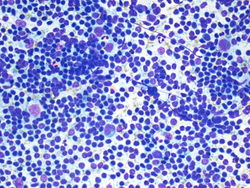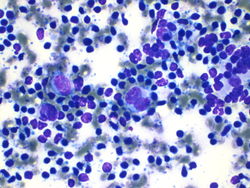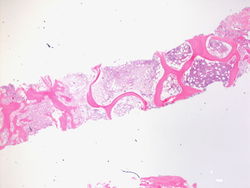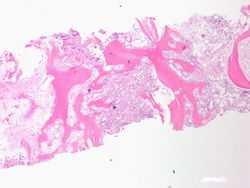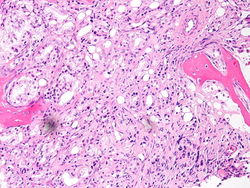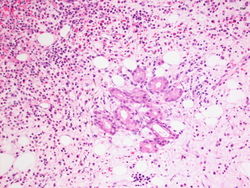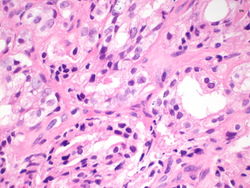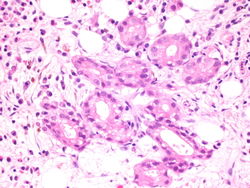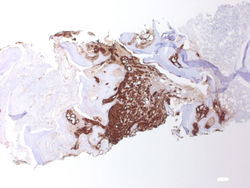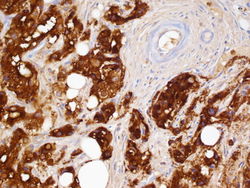Difference between revisions of "Cytologically Yours: CoW: 20131202"
| Line 38: | Line 38: | ||
====Resident Questions==== | ====Resident Questions==== | ||
| − | * <spoiler text="What is your differential diagnosis?">These groups of cells demonstrate malignant appearing cells in a background of an otherwise benign appearing lymphoid background. The atypical cells are scattered, with large nucleoli and several binucleate forms. In addition, there seem to be an increased number of eosinophils in the background. The differential diagnosis includes Hodgkin lymphoma; however, the possibility of the large atypical cells being melanoma cannot be ruled out. </spoiler> | + | * <spoiler text="What is your differential diagnosis?">These groups of cells demonstrate malignant appearing cells in a background of an otherwise benign appearing lymphoid background. The atypical cells are scattered, with large nucleoli and several binucleate forms. In addition, there seem to be an increased number of eosinophils in the background. The differential diagnosis includes Hodgkin lymphoma; however, the possibility of the large atypical cells being melanoma cannot be ruled out. </spoiler> |
| − | * <spoiler text="What would you | + | * <spoiler text="What ancillary tests would you recommend?">For this patient, we recommended that the radiologist perform a biopsy of the lesion so that it could be sent for immunohistochemical workup. Since the overall percentage of the atypical cells were low, we were worried that a cell block would not contain enough of the malignant cells for additional stains. We also sent the lymph node for flow since a hematologic malignancy was suspected; however, with Hodgkin lymphoma, we don't expect any diagnostic findings from flow cytometry.</spoiler> |
===Biopsy=== | ===Biopsy=== | ||
| Line 67: | Line 67: | ||
==Final Diagnosis== | ==Final Diagnosis== | ||
===Cytology=== | ===Cytology=== | ||
| − | * '''Positive for malignancy'''. | + | * '''Positive for malignancy, the differential diagnosis includes melanoma and Hodgkin lymphoma'''. |
===Biopsy=== | ===Biopsy=== | ||
| − | * ''' | + | * '''Classical Hodgkin lymphoma, favor mixed type'''. |
==Case Discussion== | ==Case Discussion== | ||
Revision as of 20:09, 14 January 2014
Contents
Clinical Summary
The patient is an 60 year old male with a remote history of an abdominal melanoma that was excised with negative margins. The patient has been experiencing lower back pain for the past several months and has received epidural injections. As a part of the workup, the patient had a CT which revealed retroperitoneal lymphadenopathy. A CT guided fine needle aspiration and biopsy of a paracaval lymph node was performed.
Past Medical History
- 2003 Melanoma
- Diabetes
- Hypertension
Past Surgical History
- 2013 Arthroscopic knee surgery
- 2003 Excision of melanoma
- 2002 Discectomy
Clinical Plan
The differential diagnosis for otherwise asymptomatic lymphadenopathy in this patient is melanoma, lymphoma, or occult malignancy.
Radiology
- PET CT showed hypermetabolic activity with an SUV of 12.7.
- CT of abdomen and pelvis showed adenopathy adjacent to the aorta and inferior to the vena cava at the level of the right kidney. The largest node measured 4 cm in greatest dimension.
CT
Pathology
Cytology
Resident Questions
Biopsy
Immunohistochemistry
Resident Questions
Final Diagnosis
Cytology
- Positive for malignancy, the differential diagnosis includes melanoma and Hodgkin lymphoma.
Biopsy
- Classical Hodgkin lymphoma, favor mixed type.
Case Discussion
This is a classic case of prostatic adenocarcinoma, metastatic to the spine.
| ||||||||
